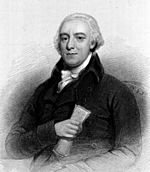Thames River Police facts for kids
Quick facts for kids Thames River Police |
|
|---|---|
| Agency overview | |
| Formed | 1800 |
| Preceding agency |
|
| Dissolved | 1839 |
| Superseding agency | Metropolitan Police Service |
| Jurisdictional structure | |
| Operations jurisdiction | River Thames and in its vicinity, England |
| General nature | |
The Thames River Police was a special police force in London, England. It was created in 1800 to stop theft and crime on the River Thames. Before this, a group called the Marine Police started in 1798. Some people say the Marine Police was the very first police force in England! The Thames River Police later joined with the Metropolitan Police Service in 1839. Today, its work continues as the Marine Policing Unit. Their main base has always been in Wapping High Street.
Contents
The First River Police
By the late 1790s, merchants were losing a lot of money. About £500,000 worth of goods were stolen each year from ships on the Pool of London part of the River Thames. This was a huge problem.
Starting the Marine Police
To fix this, a plan was made in 1797. John Harriott, a sailor and local official, teamed up with Patrick Colquhoun, a magistrate. They also got help from Jeremy Bentham, a famous thinker.
Colquhoun convinced merchants to pay for a new police force. These merchants traded with the West Indies and lost a lot of goods to thieves. They agreed to try the new force for one year.
On July 2, 1798, the Marine Police began its work. Colquhoun was the main magistrate, and Harriott was the resident magistrate.
How They Worked
The Marine Police got £4,200 to start. They rented a building where Wapping Police Station is now. They hired a "Superintendent of Ship Constables" and five "surveyors." These surveyors patrolled the river day and night. They were rowed in open boats by "police watermen."
They also had surveyors who checked ships being loaded and unloaded. "Ship constables" watched over the workers. These constables were paid by ship owners but managed by the Marine Police. On land, a "Surveyor of Quays" and his team watched over goods on the docks.
Facing Challenges and Success
The force had to police about 33,000 workers on the river. Many of these workers were involved in crime. At first, the police were not liked by some dock workers. These workers did not want to lose their illegal earnings.
A large group of about 2,000 people tried to burn down the police office. During the fight, Gabriel Franks, one of the new police officers, was killed. He was the first officer to die while on duty for this new force.
Despite these problems, Colquhoun reported that the force was a success after its first year. His officers had saved £122,000 worth of stolen goods. They also rescued several lives.
The Thames River Police is Formed
News of the Marine Police's success spread quickly. Patrick Colquhoun wrote a book about it. He suggested that the government should fully fund a police force.
In 1800, the government passed a new law called the Depredations on the Thames Act 1800. This law officially created the Thames River Police. It also gave them new police powers.
The force was in charge of crimes on the River Thames and nearby areas. This included parts of Middlesex, Surrey, Kent, Essex, and areas of Westminster and the Tower of London.
By 1829, the Thames River Police had grown. They had three stations in Wapping, Waterloo, and Blackwall. In 1839, the Thames River Police joined with the Metropolitan Police Service. This new group became known as the Thames Division.
Lasting Impact
Historians say that Colquhoun's ideas were very important. They helped lead to Robert Peel's "new" police force about 30 years later. The Thames River Police, along with the Bow Street Runners, eventually became part of the Metropolitan Police.
Colquhoun showed that a police force could prevent crime. He used a smart approach to get support from businesses. Unlike other police groups at the time, the river police were full-time officers. They were paid a salary and could not take extra fees.
Colquhoun's biggest contribution was the idea of crime prevention. He believed that police should be present to stop crimes from happening. He saw fighting crime as a science. He wanted to use this science to help the country's economy.
The Metropolitan Police Service still remembers its founders. Some of their police boats are named after them. These include the John Harriott and the Patrick Colquhoun. There is also a boat named Gabriel Franks, honoring the officer who died on duty.


